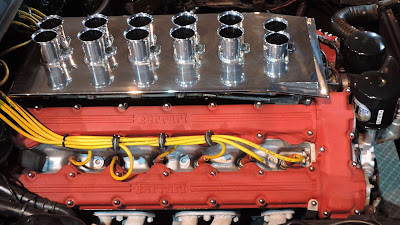Forgotten LEGEND - Not long ago, we explored the lineage of the Pontiac Banshee—from the original 1965 XP-833 to the futuristic Banshee IV of 1988. This time, we're turning our attention to another exciting and often overlooked concept from Pontiac's experimental archives: the Pontiac Pegasus Concept.
 |
| This is the Pontiac Pegasus Concept was built as a "design concept" study from a production 1970 Pontiac Firebird. (Picture from: CarBibles) |
 The name Pegasus evokes imagery that is both powerful and imaginative—aptly chosen for a concept car that marries American muscle with Italian flair. The name is a clever blend of Pontiac’s own Firebird and the mythical winged horse. While it’s unclear whether the Pegasus name was a deliberate nod—or challenge—to Ferrari’s iconic "Prancing Horse" emblem, the similarities are striking. In fact, the car sported its own custom Pegasus logo on the grille and a Porsche-like coat of arms on the hood.
The name Pegasus evokes imagery that is both powerful and imaginative—aptly chosen for a concept car that marries American muscle with Italian flair. The name is a clever blend of Pontiac’s own Firebird and the mythical winged horse. While it’s unclear whether the Pegasus name was a deliberate nod—or challenge—to Ferrari’s iconic "Prancing Horse" emblem, the similarities are striking. In fact, the car sported its own custom Pegasus logo on the grille and a Porsche-like coat of arms on the hood.  |
| Here's an V12 engine of the Ferrari 365 GTB/4 resides under the hood of the Pontiac Pegasus Concept. (Picture from: CarBibles) |
If your first thought was that the Pegasus must be related to the Firebird, you’re absolutely right. The original sketch reportedly came from designer Jerry Palmer, who was experimenting with Ferrari-inspired aesthetics. His ideas were later championed and brought to life by GM’s legendary VP of Design, William "Bill" Mitchell. The final product reflected a strong influence from the then-upcoming 1970 Pontiac Firebird, especially in the nose and fender vents, which were unmistakably Ferrari-esque.
 |
| The Pontiac Pegasus Concept inspired by Ferrari designs ranging from the front end, grille and fender vents. (Picture from: Cars and Adventures) |
But unlike many concept cars that are just rolling design studies, the Pegasus had serious engineering under its skin.
According to GM Heritage archives, the heart of the Pegasus came from none other than Ferrari itself: a V12 engine from the Ferrari 365 GTB/4, mated to a 5-speed manual transmission. Hard to believe? Enzo Ferrari, famously protective of his brand, allegedly donated the powertrain. Whether this was a gesture of goodwill or a one-time anomaly, it's still one of the most fascinating pieces of the Pegasus story.
 |
| The Pontiac Pegasus Concept’s cabin was outfitted with a sporty three-spoke steering wheel, complemented by Ferrari-sourced instrument panel gauges, adding an authentic European performance touch to the interior design. (Picture from: Cars and Adventures) |
The Italian connection didn’t stop there. The exhaust system, mufflers, and even the instrument panel came from Ferrari. Meanwhile, GM-sourced components grounded the Pegasus in Detroit: a GM traction rear axle, Corvette brakes, and Borrani wheels—the latter being another nod to European performance.
 |
| The Pontiac Pegasus Concept’s cabin was outfitted with a sporty three-spoke steering wheel, complemented by Ferrari-sourced instrument panel gauges, adding an authentic European performance touch to the interior design. (Picture from: CarBibles) |
As noted by Cars and Adventures, the Pegasus was rich in design details. A racing-style gas cap on the trunk, later echoed in the 1974 Pontiac Banshee III, and fog lights hinted at European grand tourers. Yet, there were distinctly American touches as well. Like the hood-mounted air cleaner, reminiscent of the Firebird Formula and 1969 Trans Am, which harnessed cold air for performance. Perhaps the most eccentric feature was a full-sized spare tire, proudly displayed under the rear glass—a likely homage to old-school racing regulations.
 |
| The Pontiac Pegasus Concept rode on elegant Borrani wire wheels and featured several intriguing design elements, including a racing-inspired gas cap on the trunk, along with a Ferrari-sourced exhaust system and mufflers. (Picture from: MotorBiscuit) |
In our view, the Pontiac Pegasus was more than a design exercise. It was a passion project, born in an era when GM was the world’s largest automaker and the future of performance vehicles was anything but certain.
 The Pegasus fused the best of both worlds—American muscle and European elegance—and remains a rare artifact from a bold and experimental period in automotive history. Sadly, it never made it past the concept stage. Today, it rests in quiet glory at the GM Heritage Center, preserved as a symbol of what might have been. *** [EKA FROM VARIOUS SOURCES | GM | CARBIBLES | CARS AND ADVENTURES | MOTORBISCUIT ]
The Pegasus fused the best of both worlds—American muscle and European elegance—and remains a rare artifact from a bold and experimental period in automotive history. Sadly, it never made it past the concept stage. Today, it rests in quiet glory at the GM Heritage Center, preserved as a symbol of what might have been. *** [EKA FROM VARIOUS SOURCES | GM | CARBIBLES | CARS AND ADVENTURES | MOTORBISCUIT ]Note: This blog can be accessed via your smart phone
